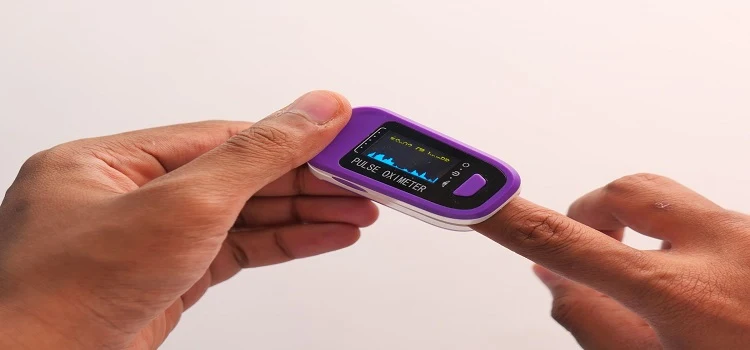So what is a pulse oximeter?
A pulse oximeter is a compact medical device that measures blood oxygen saturation (SpO2) and pulse rate. It shines a light on the skin and shows how much oxygen your blood is carrying. Non-invasive, painless, it is often used in hospitals, clinics, and even at home.
Why do I need to take an oximeter reading using a finger?
The capillary density of your finger is the best way for the device to get a good sense of your oxygen levels. Other areas, such as your earlobe or toes, can also be used, but the fingers are a good value for most people.
What do we understand by a pulse oximeter reading?
Gives two very precise readings:
Oxygen Saturation : This measures the percentage of oxygen-carrying hemoglobin in your blood. A normal SpO2 level is 95.5% to 100%.
Common Pulse Rate: This is your heart rate, usually measured in beats per minute (BPM).
If your SpO2 is below 90.5%, it signals a medical emergency.
Pulse oximeters use a combination of red and infrared light to estimate oxygen levels. The light passes through your skin and is absorbed differently by oxygen-rich and oxygen-poor blood. The machine's sensors can calculate your oxygen saturation based on the amount of light absorbed.
How much can I buy a pulse oximeter for?
Pulse oximeters are available at various price points ranging from $25 to $99.99, depending on the brand, features, as soon as accuracy you choose. Basic models are available at affordable prices, while premium machines have Bluetooth connectivity. They come with additional features like built-in apps.
What is the Perfusion Index (PI) in a Pulse Oximeter?
Perfusion Index (PI) is a measure of the strength of blood flow at the sensor site. A higher PI means better blood flow, which helps to provide reliable readings. This is a necessary metric to ensure good circulation, usually for those with poor circulation.
How accurate are the results of a pulse oximeter?
Pulse oximeters are extremely important for everyday use, but their accuracy varies based on several factors:
Usually movement during measurement
Skin pigmentation
Modern devices have an accuracy of ±2%..
So, can your pulse oximeter detect COVID-19 infection?
While a pulse oximeter cannot diagnose COVID-19, it does a good job of monitoring for adverse symptoms, such as hypoxia (low oxygen levels), a common complication of the virus. It is generally a good tool for catching early signs of respiratory distress.
Which finger will give the best results for reading a pulse oximeter?
Experts generally recommend that the middle finger of your hand provides the most accurate reading. This is because it has the best blood flow and is less obstructed than other fingers. The index finger is another good option if the middle finger is not accessible.
So which is the best pulse oximeter?
Typically very high accuracy and reliability
Large display is good for easy reading
Brands like Massimo, Nonin, and Beurer are renowned for their quality.
Why should you have a pulse oximeter at home?
Having a pulse oximeter at home is like having a health guardian on standby for specific purposes. It is essential to:
Monitoring the condition of chronic diseases such as COPD or asthma
Find out the symptoms of COVID-19 by wearing glasses
Typically tracking recovery after surgery
Factors That Can Affect Oximeter Finger Readings
Several factors can affect the accuracy of your reading, such as:
Cold Fingers: make less blood flow can distort results.
Nail Polish and Artificial Nails: These can interfere with the light sensor.
Motion Artifacts: Movement during measurement can cause viewing errors.
Skin Tone: Dark skin can affect reading somewhat, although modern devices are designed to minimize this.
Last words
Choosing the right finger for a pulse oximeter can make a big difference in the accuracy of your particular reading. The middle finger of your hand is the best option, but ensuring proper conditions – such as clean, warm fingers – is just as important. A pulse oximeter is a small but powerful tool for keeping your health in check, so use it wisely!
FAQ
Which finger is important for pulse oximeter reading?
Yes, but fingers help give faster and more reliable readings.
Why does nail polish affect the accuracy of a pulse oximeter?
Yes, dark nail polish and artificial nails affect the sensor.
Why is an expensive pulse oximeter worth it?
While basic models are more than enough for most people, premium devices can offer better app integration for better monitoring.










0 Comments